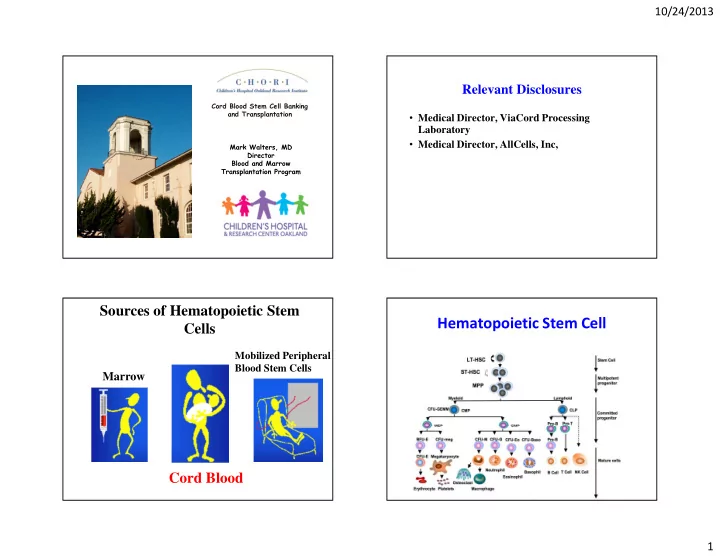

10/24/2013 Relevant Disclosures ����������������������������� ������������������� • Medical Director, ViaCord Processing Laboratory • Medical Director, AllCells, Inc, ���������������� �������� ����������������� ����������������������� Sources of Hematopoietic Stem Hematopoietic Stem Cell Cells Mobilized Peripheral Blood Stem Cells Marrow Cord Blood 1
10/24/2013 Diseases Treatable by Hematopoietic Cell Transplantation Malignant disorders Hereditary disorders • Leukemia/pre-leukemia Hemoglobinopathies • Congenital bone marrow failure • Non-Hodgkin ’ ’ ’ s and ’ • syndromes Hodgkin ’ ’ s Lymphoma ’ ’ • Congenital immunodeficency • Multiple Myeloma syndromes • Solid tumors Inborn errors of metabolism • Wiskott-Aldrich syndrome • Umbilical cord blood Umbilical cord blood immunology stem cell biology • Compared to adult blood, cord blood has more abundant • Higher number of stem cells than adult naïve T cells, fewer suppressor T cells, and similar NK and peripheral blood LAK activity • Cord blood T cells: • Myeloid precursor numbers similar to • proliferate in response to antigen marrow • show decreased cytotoxicity • Earliest stem cells (CD34+) show high self- • Alloantigen priming induces state of unresponsiveness renewal capacity • Reduced risk of Graft-versus-Host Disease • Plasticity of stem cells – possibility of tissue repair? 2
10/24/2013 UCB and Marrow from URD NMDP transplantations by hematopoietic cell source. Bone Marrow UCB US Availability* 10.5 million 185,000 CBUs donors Acceptable 1-HLA allele 2 HLA antigens Mismatch Search time 6 weeks – 6 <1 month mos. 2 nd stem collection? Yes No Ease of delivery Often difficult Easy CMV/EBV Yes No Risk to donor Minimal None * 14 million marrow and 400,000 CBUs available worldwide Effect of cell dose on recovery after HLA-ID sibling UCBT Effect of cell dose transplant-related mortality after URD for malignancies UCB transplantation Barker J N et al. Blood 2010;115:1843-1849 Herr A et al. Blood 2010;116:1849-1856 3
10/24/2013 Private Cord Blood Banking – Academy Private Cord Blood Banking – Recommendations Academy Recommendations ACOG Opinion – February 2008 AAP Recommendations regarding UCB storage (January 2007) • If a patient requests information on umbilical cord banking, balanced and Cord blood donation should be discouraged when cord blood stored in a bank is • accurate information regarding the advantages and disadvantages of public to be directed for later personal or family use, because most conditions that versus private umbilical cord blood banking should be provided might be helped by cord blood stem cells already exist in the infant’s cord blood • Discussion may include information regarding maternal infectious disease (ie, premalignant changes in stem cells) and genetic testing, the ultimate outcome of use of poor quality units of umbilical cord blood Directed cord blood banking should be encouraged when there is knowledge of a • • Some states have passed legislation requiring physicians to inform their full sibling in the family with a medical condition (malignant or genetic) that patients about umbilical cord blood banking options could potentially benefit from cord blood transplantation • Directed donation of umbilical cord blood should be considered when there Cord blood donation should be encouraged when the cord blood is stored in a • is a specific diagnosis of a disease known to be treatable by hematopoietic bank for public use transplant for an immediate family member Because there are no scientific data at the present time to support autologous • • The collection should not alter routine practice for the timing of umbilical cord blood banking private storage of cord blood as “biological insurance” should cord clamping. be discouraged (est 0.04% to 0.005% chance of using own cord blood by 21 years • Physicians who recruit pregnant women and their families for for-profit – Ballen et al BBMT, 14:356, 2008 ) umbilical cord blood banking should disclose any financial interests Sibling Cord Blood collections by state (Jan. 2012) � Families with children who have disorders treated by Hematopoietic Cell Transplantation � Prospective, full sibling pregnancies � Resource to collect, transport, characterize and cryopreserve sibling cord blood units in a central Umbilical Cord Blood Banking Facility � Remote sites & community hospitals 4
10/24/2013 Sibling UCBT by Indication (N=151) (Jan. 2013) Total Sibling Collections= 3448 Thalassemia, 5% 32 Oncology, 48 Oncology 25% Other Rare 55% Sickle Cell 14% Thalassemia Sickle Cell disease, 39 Rare, 32 1% Sibling Cord Blood Bank: Fraction of CBUs Number and indications for sibling CBU Releases by year released for UCBT 50 Thalassemia 45 Sickle Cell disease 40 Rare 35 Oncology 30 Autologous 4% 25 20 Malignant Diseases 47 15 Sickle Cell 37 10 Other/Rare 27 5 Thalassemia 30 ����������������������� ��������� 0 1996 1997 1998 1999 2000 2001 2002 2003 2004 2005 2006 2007 2008 2009 2010 2011 2012 Jan 2012 5
10/24/2013 Animal models of brain injury suggest a benefit in neurologic outcome and survival after UCB infusion ������������������������������������� � �������������������������������������������� � ���������������������������� ����������� � !���"�#$������� Future applications of UCB and cord tissue STEM CELL PLASTICITY AND TISSUE REGENERATION? ������� %�����&'���������� � �� ���������� ������� #(()* �� ������������������ 6
10/24/2013 Phase I Investigation of Autologous UCB in Phase I Investigation of Autologous UCB in Children with acquire CNS injury Children with acquire CNS injury �������+��*��������'�������������������� Visit 1 Visit 1 Visit 2 Visit 2 Visit 3 Visit 3 Phone Phone CBU Screen and CBU Screen and (1 st Year) (1 st Year) (2 nd Year) (2 nd Year) ������������ �������������,�������������� (time 0) (time 0) Screen Screen Shipment to Duke Shipment to Duke � -����.'/���� Qualifying Qualifying � ������������������� Visit Visit � 0�����!�����%��������!�������10!%!2���3���1��'��2 Evaluation Evaluation Evaluation Evaluation R R A A ������4�����'�3��������� N N D D �������*�.���*�#��� � Enrolled On Enrolled On O O Arm 1 Arm 1 UCB UCB Placebo Placebo Evaluation Evaluation M M Study Study I I �3��������������&��*���������4�&�� �������*�!��� Z Z 1�����������������������2*�56� E E D D Arm 2 Arm 2 Placebo Placebo UCB UCB ������������������78(9����������������������� 0!%!����������.����� ������������������������#(.( Mesenchymal Stem Cells MSC activities After Caplan � ��!�����������������������������������!��������������"��#��$ � %������������#������������&�����#����������� � '����%%���%��������$ Stromal Osteoblast Chondrocyte Myoblast Tendoblast Pereadipocyte � ���%���(���%%�������������%%����$���������� Fibroblast � '����������(�����"�����&��"���&"��$��)����������� Osteocyte Chondrocyte Myocyte Stromal Cells Tendocyte Adipocyte � �����������$���&��&������ Bone Cartilage Muscle Stroma Tendon Adipose 7
Recommend
More recommend